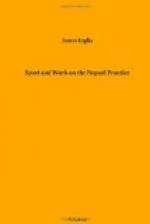To cure skins. I know no better recipe than the one adopted by my trainers in the art of shibar, the brothers S. I cannot do better than give a description of the process in the words of George himself.
’Skin the animal in the usual way. Cut from the corner of the mouth, down the throat, and along the belly. A white stripe or border generally runs along the belly. This should be left as nearly as possible equal on both sides. Carefully cut the fleshy parts off the lips and balls of the toes and feet. Clean away every particle of fatty or fleshy matter that may still adhere to the skin. Peg it out on the ground with the hair side undermost. When thoroughly scraped clean of all extraneous matter on the inner surface, get a bucket or tub of buttermilk, which is called by the natives dahye or mutha. It is a favourite article of diet with them, cheap and plentiful. Dip the skin in this, and keep it well and entirely submerged by placing some heavy weight on it. It should be submerged fully three inches in the tub of buttermilk.
’After two days in the milk bath, take it out and peg it as before. Now take a smooth oval rubbing-board about twelve inches long, five round, and about an inch thick in the middle, and scrub the skin heartily with this instrument. On its lower surface it should be cuts in grooves, semicircular in shape, half an inch wide, and one inch apart. During scrubbing use plenty of pure water to remove filth. In about half an hour the pinkish-white colour will disappear, and the skin will appear white, with a blackish tinge underneath. This is the true hide.
’Again submerge in the buttermilk bath for twenty-four hours, and get a man to tread on it in every possible way, folding it and unfolding it, till all has been thoroughly worked.
’Take it out again, peg out and scrub it as before, after which wash the whole hide well in clear water. Never mind if the skin looks rotten, it is really not so.
’When washed put it into a tub, in which you have first placed a mixture consisting of half an ounce of alum to each gallon of water. Soak the skin in this mixture for about six hours, taking it up occasionally to drain a little. This is sufficient to cure your skin and clean it.’
The tanning remains to be done.
’Get four pounds of babool, tamarind, or dry oak bark. (The babool is a kind of acacia, and is easily procurable, as the tamarind also is). Boil the bark in two gallons of water till it is reduced to one half the quantity. Add to this nine gallons of fresh water, and in this solution souse the skin for two, or three, or four days.
’The hairs having been set by the soaking in alum, the skin will tan more quickly, and if the tan is occasionally rubbed into the pores of the skin it will be an improvement. You can tell when the tanning is complete by the colour the skin assumes. When this satisfies the eye, take it out and drain on a rod. When nearly dry it should be curried with olive oil or clarified butter if required for wear, but if only for floor covering or carriage rug, the English curriers’ common ‘dubbin,’ sold by shopkeepers, is best. This operation, which must be done on the inner side only, is simple.




